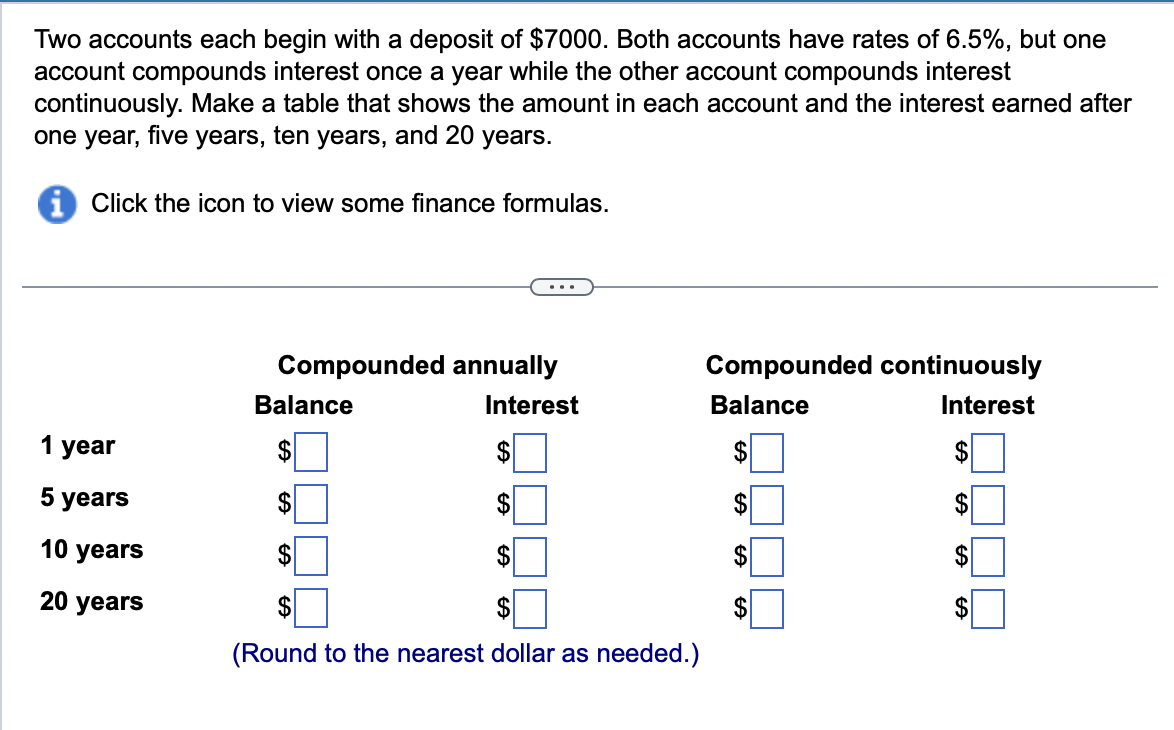Two accounts each begin with a deposit of $7000. Both accounts have rates of 6.5%, but one account compounds interest once a year while the other account compounds interest continuously. Make a table that shows the amount in each account and the interest earned after one year, five years, ten years, and 20 years. i Click the icon to view some finance formulas. 1 year Compounded annually Interest $ Balance $ Compounded continuously Balance Interest $ $
Two accounts each begin with a deposit of $7000. Both accounts have rates of 6.5%, but one account compounds interest once a year while the other account compounds interest continuously. Make a table that shows the amount in each account and the interest earned after one year, five years, ten years, and 20 years. i Click the icon to view some finance formulas. 1 year Compounded annually Interest $ Balance $ Compounded continuously Balance Interest $ $
Cornerstones of Financial Accounting
4th Edition
ISBN:9781337690881
Author:Jay Rich, Jeff Jones
Publisher:Jay Rich, Jeff Jones
ChapterA3: Time Value Of Money
Section: Chapter Questions
Problem 3CE
Related questions
Question

Transcribed Image Text:Two accounts each begin with a deposit of $7000. Both accounts have rates of 6.5%, but one
account compounds interest once a year while the other account compounds interest
continuously. Make a table that shows the amount in each account and the interest earned after
one year, five years, ten years, and 20 years.
iClick the icon to view some finance formulas.
1 year
5 years
10 years
20 years
Compounded annually
Interest
$
$
Balance
$
$
$
$
$
$
(Round to the nearest dollar as needed.)
Compounded continuously
Balance
Interest
$
$

Transcribed Image Text:In the provided formulas, A is the balance in the account after t years, P is the
principal investment, r is the annual interest rate in decimal form, n is the number
of compounding periods per year, and Y is the investment's effective annual yield
in decimal form.
nt
A=P(1 + - m²
P=
=
A
nt
(1 + 1)²
A = Pert
n
Y = (₁+) ^-₁
1
Expert Solution
This question has been solved!
Explore an expertly crafted, step-by-step solution for a thorough understanding of key concepts.
This is a popular solution!
Trending now
This is a popular solution!
Step by step
Solved in 4 steps with 1 images

Knowledge Booster
Learn more about
Need a deep-dive on the concept behind this application? Look no further. Learn more about this topic, finance and related others by exploring similar questions and additional content below.Recommended textbooks for you

Cornerstones of Financial Accounting
Accounting
ISBN:
9781337690881
Author:
Jay Rich, Jeff Jones
Publisher:
Cengage Learning

Financial Accounting: The Impact on Decision Make…
Accounting
ISBN:
9781305654174
Author:
Gary A. Porter, Curtis L. Norton
Publisher:
Cengage Learning

EBK CONTEMPORARY FINANCIAL MANAGEMENT
Finance
ISBN:
9781337514835
Author:
MOYER
Publisher:
CENGAGE LEARNING - CONSIGNMENT

Cornerstones of Financial Accounting
Accounting
ISBN:
9781337690881
Author:
Jay Rich, Jeff Jones
Publisher:
Cengage Learning

Financial Accounting: The Impact on Decision Make…
Accounting
ISBN:
9781305654174
Author:
Gary A. Porter, Curtis L. Norton
Publisher:
Cengage Learning

EBK CONTEMPORARY FINANCIAL MANAGEMENT
Finance
ISBN:
9781337514835
Author:
MOYER
Publisher:
CENGAGE LEARNING - CONSIGNMENT

Principles of Accounting Volume 1
Accounting
ISBN:
9781947172685
Author:
OpenStax
Publisher:
OpenStax College

Excel Applications for Accounting Principles
Accounting
ISBN:
9781111581565
Author:
Gaylord N. Smith
Publisher:
Cengage Learning

Principles of Accounting Volume 2
Accounting
ISBN:
9781947172609
Author:
OpenStax
Publisher:
OpenStax College